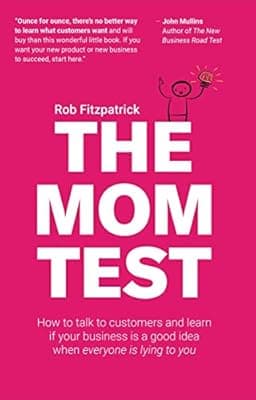
The Mom Test: How to talk to customers & learn if your business is a good idea when everyone is lying to you
by Rob Fitzpatrick
20 highlights
Highlights
Doing it wrong is worse than doing nothing at all. When you know you’re clueless, you tend to be careful. But collecting a fistful of false positives is like convincing a drunk he’s sober: not an improvement.
Page 3
The measure of usefulness of an early customer conversation is whether it gives us concrete facts about our customers’ lives and world views.
Page 5
The Mom Test: Talk about their life instead of your idea Ask about specifics in the past instead of generics or opinions about the future Talk less and listen more
Page 7
While using generics, people describe themselves as who they want to be, not who they actually are. You need to get specific to bring out the edge cases.
Page 25
Startups are about focusing and executing on a single, scalable idea rather than jumping on every good one which crosses your desk.
Page 29
Keep your idea and your ego out of the conversation until you’re ready to ask for commitments.
Page 35
Being pitchy is the dark side of the “seeking approval” coin. Instead of inviting compliments by being vulnerable, you’re demanding them by being annoying. It’s when you hold someone hostage and won’t let them leave until they’ve said they like your idea.
Page 35
Rule of thumb: Anyone will say your idea is great if you’re annoying enough about it.
Page 36
In addition to ensuring that you aren’t asking trivialities, you also need to search out the world-rocking scary questions you’ve been unintentionally shrinking from.
Page 39
You can tell it’s an important question when its answer could completely change (or disprove) your business. If
Page 39
Every time you talk to someone, you should be asking at least one question which has the potential to destroy your currently imagined business.
Page 39
The classic error in response to a lukewarm signal is to “up your game” and pitch them until they say something nice. Unless they’re holding a check, the only thing to gain from “convincing” them are false positives. You’re not here to collect compliments; you’re trying to learn the truth. Their lukewarm response already gave you that.
Page 42
Rule of thumb: Start broad and don't zoom in until you’ve found a strong signal, both with your whole business and with every conversation.
Page 50
Product risk — Can I build it? Can I grow it? Customer/market risk — Do they want it? Will they pay me? Are there lots of them?
Page 54
Pre-plan the 3 most important things you want to learn from any given type of person (e.g. customers, investors, industry experts, key hires, etc). Update the list as your questions change.
Page 55
Rule of thumb: Learning about a customer and their problems works better as a quick and casual chat than a long, formal meeting.
Page 59
But there’s a big time cost to formality, and it tends to clobber much of the learning we hoped to achieve.
Page 60
Rule of thumb: If you don’t know what happens next after a product or sales meeting, the meeting was pointless.
Page 68
Rule of thumb: It’s not a real lead until you’ve given them a concrete chance to reject you.
Page 74
Rule of thumb: In early stage sales, the real goal is learning. Revenue is a side-effect.
Page 76